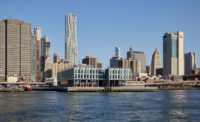Another Makeover for NYC's South Street Seaport?

NYC South Street Seaport
SHoP Architects has designed a new scheme for Manhattan’s South Street Seaport, which has been revamped seemingly every few decades since it was built on a landfill during the 1700s. The new scheme has its critics: Area residents object that a 495-foot-tall hotel/condo tower would block their views and would set a precedent for more high-rises.
Image courtesy General Growth Properties

NYC South Street Seaport
SHoP Architects has designed a new scheme for Manhattan’s South Street Seaport, which has been revamped seemingly every few decades since it was built on a landfill during the 1700s. The new scheme has its critics: Area residents object that a 495-foot-tall hotel/condo tower would block their views and would set a precedent for more high-rises.
Image courtesy General Growth Properties

NYC South Street Seaport
SHoP Architects has designed a new scheme for Manhattan’s South Street Seaport, which has been revamped seemingly every few decades since it was built on a landfill during the 1700s. The new scheme has its critics: Area residents object that a 495-foot-tall hotel/condo tower would block their views and would set a precedent for more high-rises.
Image courtesy General Growth Properties

NYC South Street Seaport
SHoP Architects has designed a new scheme for Manhattan’s South Street Seaport, which has been revamped seemingly every few decades since it was built on a landfill during the 1700s. The new scheme has its critics: Area residents object that a 495-foot-tall hotel/condo tower would block their views and would set a precedent for more high-rises.
Image courtesy General Growth Properties

NYC South Street Seaport
SHoP Architects has designed a new scheme for Manhattan’s South Street Seaport, which has been revamped seemingly every few decades since it was built on a landfill during the 1700s. The new scheme has its critics: Area residents object that a 495-foot-tall hotel/condo tower would block their views and would set a precedent for more high-rises.
Image courtesy General Growth Properties

NYC South Street Seaport
SHoP Architects has designed a new scheme for Manhattan’s South Street Seaport, which has been revamped seemingly every few decades since it was built on a landfill during the 1700s. The new scheme has its critics: Area residents object that a 495-foot-tall hotel/condo tower would block their views and would set a precedent for more high-rises.
Image courtesy General Growth Properties

NYC South Street Seaport
SHoP Architects has designed a new scheme for Manhattan’s South Street Seaport, which has been revamped seemingly every few decades since it was built on a landfill during the 1700s. The new scheme has its critics: Area residents object that a 495-foot-tall hotel/condo tower would block their views and would set a precedent for more high-rises.
Image courtesy General Growth Properties




Post a comment to this article
Report Abusive Comment